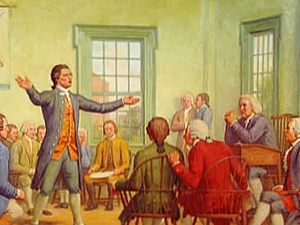Before the colonies won their freedom and the constitution was created, the only government was the Continental Congress. It was made up of delegates from each of the thirteen colonies. Nearly all high standing political figures had been apart of the Continental Congress. This included Alexander Hamilton, Thomas Jefferson, Samuel and john Adams, George Washington, Benjamin Franklin, and many more.
Americans were only becoming more and more opposed to Britain ruling over them. The Stamp Act, passed in 1765 by Parliament, only increased the number of riots and colonists wanting to break free of Britain. So, nine of the thirteen colonies had delegates to a convention to discuss the new law. They called it the Stamp Act Congress. Though it did not last long, the Stamp Act Congress encouraged the idea of winning their own freedom even more. Britain, despite the Stamp Act Congress’s attempts, refused to let go of the colonies. They still believed they had the right to enact laws on the colonies.
Twelve of the thirteen colonies sent delegates to Philadelphia on September 5, 1774. Georgia, however, was unable to send delegates as they were relying on Britain for supplies while they fought Native-Americans. This time the congress was to discuss the Coercive Acts Parliament had recently put into place. Eventually, the congress decided on a Declaration of Rights. This declaration stated that Britain should not have the right to tax them, though they were still loyal to Britain.
Not only that, but the Articles of Association were also passed. Because of it, beginning on December 1, 1774, colonists were no longer permitted to use goods coming from the British Isles. If the Coercive Acts were repealed, then the Articles of Association would be repealed. but if Parliament did not repeal the acts, the Articles of Association would not be either. Congress also declared that if Britain refused to listen to them, another meeting would be held May 10, 1775. Then, the colonies would be prohibited to have goods sent to Britain starting September 10, 1775.
The second meeting took place on, like they had earlier decided, May 10, 1775. The American Revolution had only recently begun on April 19th.
Just over a month later, the Continental Congress created the continental Army on June 14, 1775. George Washington was to be the commander in chief. In July, Thomas Jefferson and John Dickinson wrote the Declaration of the Causes of Necessity of Taking Up Arms. As Congress attempted to prevent a war from breaking out, they petitioned King George III to compromise with the Colonies. This was called the Olive Branch Petition. King George III dismissed the petition as the war for freedom was continually getting worse.
The continental Congress continued supervising and looking over their army. By early 1776, it became more clear that the colonies needed to win their independence. Thomas Paine had recently published “Common Sense”, a pamphlet, earlier that year in January. In his pamphlet, Paine spoke of his ideas for the colonies gaining independence. Many colonists also began to realize that they may be able to form allies with Britain’s enemies to help them win the war, France being the main one.
One by one, the colonies gave their delegates instruction to vote for independence in congress that spring. During that time, each colony had to provide specific instructions to allow their delegates to propose or vote for anything. Virginia instructed its delegates to propose before Congress a declaration. Richard Henry Lee, one of Virginia’s delegates, was the first to propose the idea in congress on June 7th. Votes on this matter were postponed until July 1st though. Congress did, however, have a committee appointed to begin drafting this declaration.
Thomas Jefferson had been the main author of the first draft, with help from John Adams, Benjamin Franklin, Roger Sherman, and Robert R. Livingston. Revisions and changes to the document were made before Congress voted on July 4, 1776. The delegates had voted in favor of the declaration. July 4 is now known as independence day because that was when the Declaration of Independence was approved.
Congress now had the right to find allies in the enemies of Britain. In early 1778, the colonies had formed an alliance with one of Britain’s longest standing enemies, France. They were lucky to have made this alliance because the colonies did not have a strong enough army to win.
The Articles of Confederation were soon drafted in Congress in 1777 and ratified in 1781. This was to be America’s new constitution, though later the U.S. Constitution was passed. The Articles of Confederation provided each of the new thirteen states their own equal voice in Congress. Instead of the Continental Congress, it would be called the Congress of the Confederation.
1783 was when the colonies finally ended war with Britain and their freedom was guaranteed after signing the Treaty of Paris. The Articles of Confederation would later be proven as not enough for the new country. They needed a much stronger and more stable government. Thus, the U.S. Constitution was later drafted and ratified.



